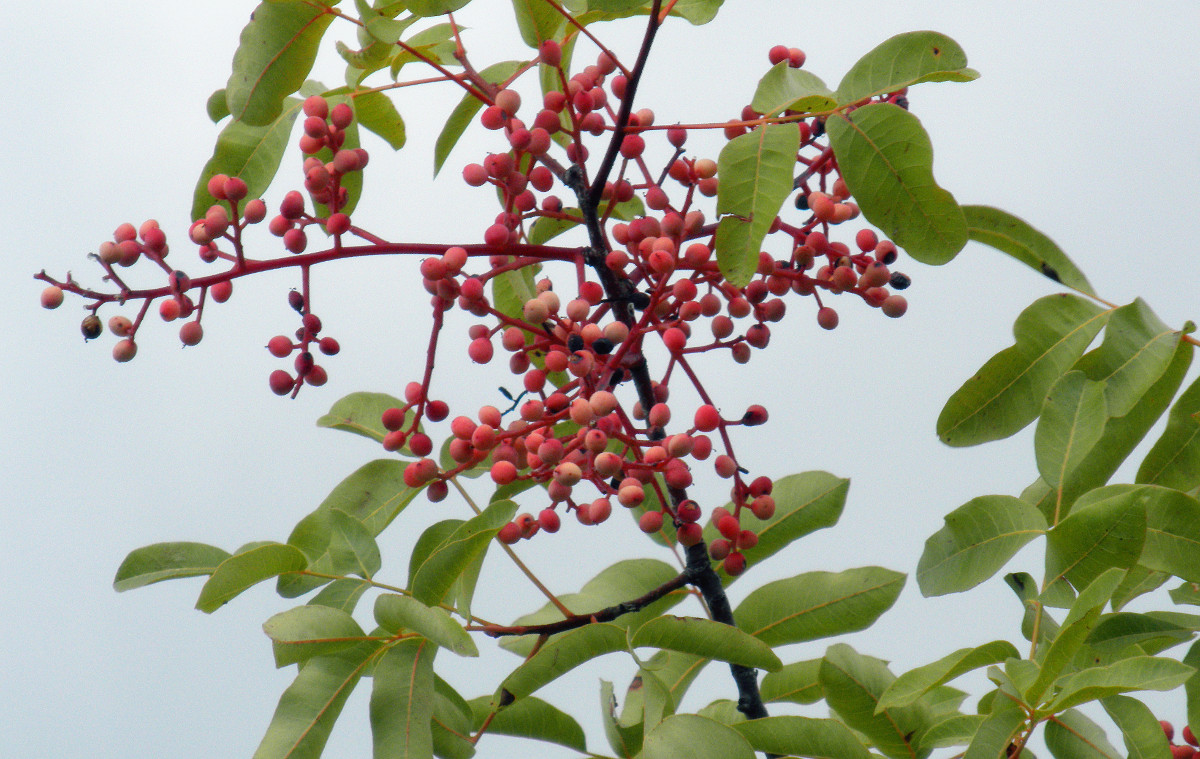Pistacia terebinthus L. - Anacardiaceae - turpentine tree, Terebinthe, Terpentin-Pistazie
Deciduous tree or large shrub, native to the Mediterranean region.
„It is used as a source for turpentine, possibly the earliest known source. The turpentine of the terebinth is now called Chian, Scio, or Cyprian turpentine.“ wikipedia
„Studies were made of the anatomical and morphological structure of the essential-oil canals in the roots, shoots, leaves and fruits of trees in a natural population in Bulgaria. Data are presented on the content of essential oil in spring, summer and autumn 1986 and 1987, for the various organs of male and female specimens. The content of essential oils was greatest in the flowering shoots in summer/autumn, being 4 times greater than that in the one-year shoots and 8-9 times greater than in the leaves. The content of essential oil is directly proportional to the number and size of the cavities (receptacles). The pedicels and fruits, collected in autumn before the onset of physiological maturity, could be a useful raw material for obtaining essential oils.“
[Study on the turpentine tree (Pistacia terebinthus) as an essential-oil plant., Robeva, P., Genov, K., Stoyanova, M., Nauka za Gorata, Vol.27(1), 1990, 38-46]
„The essential oil contents (dry weight basis) of young shoots, flowers, unripe and ripe fruits of the turpentine tree (Pistacia terebinthus L) were determined as 0.74, 0.70, 0.54 and 0.73% respectively. The main components identified by GC/MS analysis (the identified components represents 90.7, 96.1, 98.0 and 99.0% of the respective oils) were limonene (3.0, 9.4, 34.2 and 32.8%), α-pinene (5.3, 12.4, 15.6 and 5.3%), β-pinene (1.4, 8.0, 11.5 and 22.5%) and germacrene D (trace, 19.9, 3.5 and 4.6%). Minor qualitative and major quantitative variations in some compounds of the analysed oils were determined with respect to the different parts of the turpentine tree.“
[Comparative essential oil composition of various parts of the turpentine tree (Pistacia terebinthus L) growing wild in Turkey., Couladis, M., Özcan, M., Tzakou, O., Akgül, A., Journal of the Science of Food and Agriculture, Vol.83(2), 2003, 136-138]
The ripe fruits of Pistacia terebinthus L. subsp. palaestina (Boiss.) Engl. (Pistacia palaestina Boiss.) are used largely in the Middle East as a component of Zaatar, a spice mixture with thyme, oregano, marjoram, toasted sesame seeds, dried sumac, and salt. Hydrodistilled essential oil of the ripe fruits was rich in (E)-ocimene (33.8%), (Z)-ocimene (13.0%), and sabinene (24.1%). Other main constituents were α-pinene (6.5%), β-pinene (3.6%), myrcene (1.2%), limonene (4.1%), nonanal (1.1%), terpinen-4-ol (1.3%), and germacrene D (3.0%). Minor components were α-thujene (0.8%), camphene (0.4%), α-terpinene (0.5%), p-cymene (0.5%), α-terpineol (0.4%), isobornyl acetate (0.5%), α-terpinyl acetate (0.6%), γ-muurolene (0.5%), and bicyclogermacrene (0.3%) e.g.
[Composition of the essential oil of leaves, galls, and ripe and unripe fruits of Jordanian Pistacia palaestina Boiss., Flamini, G., Bader, A., Cioni, P.L., Katbeh-Bader, A., Morelli, I., Journal of agricultural and food chemistry, 52(3), 2004, 572-576]
The very attractive (fresh-green citric with piny nuances) scent of touched P.terebinthus leaves is not as rich in α-pinene (15%) as the leaf extract (73%). Headspace GC-MS showed limonene (61%) as main constituent, with neral, geranial, (Z)-3-hexenol and (Z)-3-hexenyl acetate as olfactory important components.
[Meaningful Scents around the World, R.Kaiser, 2006, 147]
„Constituents of essential oils from fruit samples of the turpentine tree (Pistacia terebinthus L.) collected from fifteen different localities of Turkey on August 2001 were identified by GC-MS. Twenty-eight compounds representing 92.3-100.0% of turpentine fruit oils were identified. The oil yields varied between 0.06% and 0.16%. The highest yield of oil was obtained from fruits of Antalya origin (Akbaş-Serik) (0.16%). α-Pinene (51.3%), limonene (39.0%), p-cymen-8-ol (40.0%) and caryophyllene oxide (51.0%) were found as major components for different localities in Turkey. The predominant constituents in most samples were α-pinene (9.5-51.3%), limonene (tr-39.0%) and caryophyllene oxide (tr-51.5). Except for one collection (Manavgat-Antalya), which contained spathulenol (20.7%) and p-cymen-8-ol (40.0%), all the other samples yielded oils rich in α-pinene and limonene. β-Caryophyllene oxide is the most abundant compound in Hisarönü (İzmir), Alanya (Antalya) and Yayladağ (Hatay) oils. Results confirm the effect of locality on the oil content and composition.“
[Essential oil composition of the turpentine tree (Pistacia terebinthus L.) fruits growing wild in Turkey., Özcan, M.M., Tzakou, O., Couladis, M., Food Chemistry, Vol.114(1), 2009, 282-285]

Blackwell,E., Herbarium Blackwellianum, vol.5 t.478 (1765) plantgenera.org

Pistacia terebinthus fruits close up, Dehesa Boyal de Puertollano, Spain, © Javier Martin, PD CC0 wikimedia
